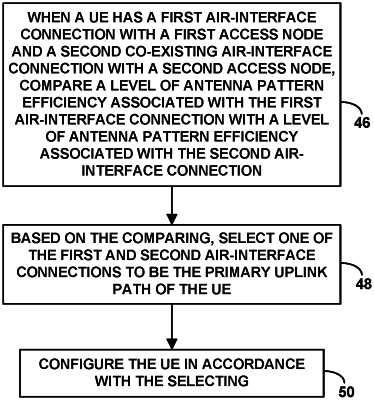| CPC H04W 28/0958 (2020.05) [H04W 28/0858 (2020.05); H04W 28/0861 (2023.05); H04W 92/10 (2013.01)] | 15 Claims |

|
1. A method for controlling uplink communication from a user equipment device (UE) that has at least two co-existing air-interface connections including a first air-interface connection with a first access node and a second air-interface connection with a second access node, wherein one of the first and second air-interface connections defines a primary uplink path of the UE to which the UE restricts uplink user-plane data transmission of the UE unless and until a trigger condition causes the UE to split the uplink user-plane data transmission of the UE between the first and second air-interface connections, the method comprising:
comparing a level of antenna pattern efficiency associated with the first air-interface connection with a level of antenna pattern efficiency associated with the second air-interface connection;
selecting, based at least on the comparing, one of the first and second air-interface connections to be the primary uplink path of the UE; and
configuring the UE in accordance with the selecting,
wherein the first access node has a first antenna structure that radiates to define a first antenna pattern defining a first coverage area in which the first air-interface connection is established, and wherein the level of antenna pattern efficiency associated with the first air-interface connection comprises a level of antenna pattern efficiency of the first antenna structure based on at least one factor selected from the group consisting of (i) a sector power ratio of the first antenna pattern and (ii) a front to back ratio of the first antenna pattern, and
wherein the second access node has a second antenna structure that radiates to define a second antenna pattern defining a second coverage area in which the second air-interface connection is established, and wherein the level of antenna pattern efficiency associated with the second air-interface connection comprises a level of antenna pattern efficiency of the second antenna structure based on at least one factor selected from the group consisting of (i) a sector power ratio of the second antenna pattern and (ii) a front to back ratio of the second antenna pattern.
|